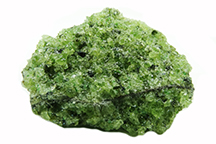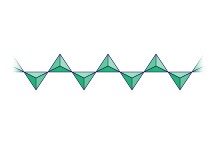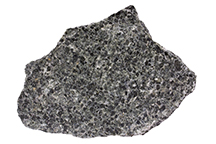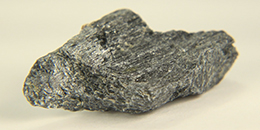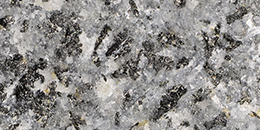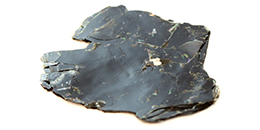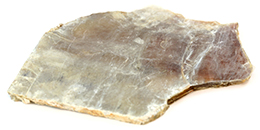The Silicate Minerals: The silica tetrahedron and Earth's most common minerals
Listen to this reading
Did you know that silicates like quartz and clay are among Earth’s most important natural resources? Imagine a world without glass, bricks, pottery, or computers – all of these rely on silicate minerals. These valuable materials make up 95% of the Earth’s crust.
The mineral quartz (SiO2) is found in all rock types and in all parts of the world. It occurs as sand grains in sedimentary rocks, as crystals in both igneous and metamorphic rocks, and in veins that cut through all rock types, sometimes bearing gold or other precious metals. It is so common on Earth's surface that until the late 1700s it was referred to simply as "rock crystal." Today, quartz is what most people picture when they think of the word "crystal."
Quartz falls into a group of minerals called the silicates, all of which contain the elements silicon and oxygen in some proportion. Silicates are by far the most common minerals in Earth's crust and mantle, making up 95% of the crust and 97% of the mantle by most estimates. Silicates have a wide variety of physical properties, despite the fact that they often have very similar chemical formulas. At first glance, for example, the formulas for quartz (SiO2) and olivine ((Fe,Mg)2SiO4) appear fairly similar; these seemingly minor differences, however, reflect very different underlying crystal structures and, therefore, very different physical properties. Among other differences, quartz melts at about 600° C while olivine remains solid to temperatures of nearly twice that; quartz is generally clear and colorless, whereas olivine received its name from its olive green color.
The variety and abundance of the silicate minerals is a result of the nature of the silicon atom, and even more specifically, the versatility and stability of silicon when it bonds with oxygen. In fact, pure silicon was not isolated until 1822, when the Swedish chemist Jöns Jakob Berzelius (see the Biography link in our Resources section) finally succeeded in separating silicon from its most common compound, the silicate anion (SiO4)4-. This anion takes the shape of a tetrahedron, with an Si4+ ion at the center and four O2- ions at the corners (see Figure 1); thus, the molecular anion has a net charge of -4.

The Si-O bonds within this tetrahedral structure are partially ionic and partially covalent, and they are very strong. Silica tetrahedra bond with each other and with a variety of cations in many different ways to form the silicate minerals. Despite the fact that there are many hundreds of silicate minerals, only about 25 are truly common. Therefore, by understanding how these silica tetrahedra form minerals, you will be able to name and identify 95% of the rocks you encounter on Earth's surface.
Seeing the structure of the silicates
Early mineralogists grouped minerals according to physical properties, which spread the silicates across many groups because they have very different properties. By the early 1800s, however, Berzelius had begun classifying minerals based on their chemical composition rather than on their physical properties, defining groups such as the oxides and sulfides – and, of course, the silicates. At the time, Berzelius was able to determine the absolute proportions of elements within a mineral, but he could not see the internal arrangement of the atoms of those elements in their crystalline structure.
A detailed view of the internal arrangement of atoms within minerals would have to wait over 100 years for the development of X-ray diffraction (XRD) by Max von Laue, and its application to determine atomic distances by the father-son team of William Henry Bragg and William Lawrence Bragg a few years later (see their biographies in our Resources section). In the process of XRD, X-rays are aimed at a crystal. Electrons in the atoms within the crystal interact with the X-rays and cause them to undergo diffraction. In the same way that light can be diffracted by a grate or card (see our Light I: Particle or Wave? module for more information on this topic), X-rays are diffracted by the crystal and a 2-dimensional pattern of constructive and destructive interference bands results. This pattern can be used to determine the distance between atoms within the crystal structure according to Bragg's Law. The Braggs' work opened up a new world of mineralogy, and they were awarded a Nobel Prize in 1915 for their work determining the crystal structures of NaCl, ZnS, and diamond. XRD revealed that even minerals with similar chemical formulas could have very different crystal structures, strongly influencing those minerals' chemical and physical properties.
As scientists created XRD images of the atomic structure of minerals, they were better able to understand the nature of the bonds between atoms in the silicate and other crystals. Within a silica tetrahedron, any single Si-O bond requires half of the available bonding electrons of the O2- ion, meaning that each O2- may bond with a second ion, including another Si4+ ion. The result of this is that the silica tetrahedra can polymerize, or form chain-like compounds, by sharing an oxygen atom with a neighboring silica tetrahedron. The silicates are, in fact, subdivided based on the shape and bonding pattern of these polymers, because the shape influences the external crystal form, the hardness and cleavage of the mineral, the melting temperature, and the resistance to weathering. These different atomic structures produce recognizable and consistent physical properties, so it is useful to understand the structures at an atomic level in order to identify and classify the silicate minerals. Identifying minerals in a rock may seem like an arcane exercise, but it is only by identifying minerals that we begin to understand the history of a given rock.
The most common silicate minerals fall into four types of structures, described in more detail below: isolated tetrahedra, chains of silica tetrahedra, sheets of tetrahedra, and a framework of interconnected tetrahedra.
Comprehension Checkpoint
Isolated tetrahedra: Olivine
The simplest atomic structure involves individual silica anions and metal cations, usually iron (Fe) and magnesium (Mg), both of which exist most commonly as ions with charge of +2. Therefore, it takes two atoms of Fe2+ or Mg2+ (or one of each) to balance the -4 charge of the silica anion. Olivine (see Figures 2a and 2b below) is the most common silicate of this type, and it makes up most of the mantle. Because these minerals contain a relatively high proportion of iron and magnesium, they tend to be both dense and dark-colored. Because the tetrahedra are not polymerized, there are no consistent planes of internal atomic weakness, so they also have no cleavage. Garnet is another common mineral with this structure.
Chains of tetrahedra: Pyroxenes and amphiboles
When silicate anions polymerize, they share an oxygen atom with a neighboring tetrahedron. Commonly, each tetrahedron will share two of its oxygen atoms, forming long chain structures. These chains still have a net negative charge, however, and the chains bond to metal cations like Fe2+, Mg2+, and Ca2+ to balance the negative charge. These metal cations commonly bond to multiple chains, forming bridges between the chains. Single-chain silicates include a common group called the pyroxenes, which are generally dark-colored (see Figures 3a and 3b). Because the bonds within the tetrahedra are strong, planes of atomic weakness do not cross the chains; instead, pyroxenes have two cleavage planes parallel to the chains and at nearly right angles to each other.
Double chains form when every other tetrahedron in a single chain shares a third oxygen ion with an adjoining chain (see Figure 4a). Like single chains, the double chains still maintain a net negative charge and bond to cations that can form bridges between multiple double chains.
Double chain silicates, called amphiboles, host a wider variety of cations, including Fe2+, Mg2+, Ca2+, Al3+, and Na+, and have a wide variety of colors. The most common amphibole is hornblende, a black mineral found in igneous rocks like granite and andesite (see Figures 4b and 4c). Amphiboles tend to form prismatic crystals with two cleavage planes at 120 degrees to each other.
Pyroxenes and amphiboles can be difficult to distinguish from one another, as they are both dark-colored, blocky minerals. A careful examination of the angle between cleavage planes, described above, is required to identify them.
Comprehension Checkpoint
Sheets: Micas and clays
When every tetrahedron shares three of its oxygen ions with neighboring tetrahedra, sheets are formed (see Figure 5a). Micas such as muscovite and biotite (see Figure 5b) are both common sheet silicates, notable for their one perfect cleavage. This perfect cleavage results from the type of bonds that occur between sheets – van der Waals bonds. Because van der Waals bonds are weak, cleavage occurs between sheets, never across sheets. Clays are another very important sheet silicate that incorporate water into their atomic structure. The presence of water lubricates the sheets and is what makes clays easy to work with in forming pottery; the firing process heats the minerals to the point where the water is driven off, resulting in a rigid, durable structure such as a pot.
Framework: Quartz and feldspar
When each tetrahedron shares all of its oxygen atoms with adjacent tetrahedra, a very strong 3-dimensional framework of Si-O bonds is formed (see Figure 6a). Quartz is pure SiO2; note that the charge is now exactly balanced and no other bonding ions are needed. In the feldspars, one or two out of every four Si4+ ions is replaced by an Al3+ ion, creating a charge imbalance that must be solved through the presence of additional cations: K+, Na+, and Ca2+. There are two kinds of feldspars upon which cations are incorporated into the structure. Feldspars that contain the K+ cation are called K-feldspars, or alkali feldspar, whereas those that contain Na+ and Ca2+ are called plagioclase feldspars (see Figure 6b). This separation occurs because K+ is a much larger cation than either Ca2+ or Na+, and its presence creates a slightly expanded framework structure.

Like olivine, quartz also has no cleavage, because there is no natural weakness within that 3-dimensional framework. The feldspars, on the other hand, have two good cleavage planes at ~90 degrees to each other, due in part to the way that the aluminum ion changes the structure slightly, opening up planes of weakness. Quartz and feldspar are generally light-colored as well, making them easily distinguishable from darker minerals like olivine and pyroxene.
Quartz and feldspar together make up the bulk of the rocks we see at the surface. Plagioclase feldspar is the single most common mineral in Earth's crust, making up an estimated 39% of both continental and oceanic crust. Quartz only makes up an estimated 12% of the entire crust, but it is by far the most common mineral we see on the surface because of its resistance to weathering.
Familiarity with these few minerals – olivine, garnet, pyroxene, hornblende, muscovite, biotite, K-feldspar, plagioclase, and quartz – prepares you to identify and interpret the vast majority of rocks you will see on Earth's surface.
Comprehension Checkpoint
Silicates as a natural resource
Though we generally think of coal or oil when discussing natural resources, silicate minerals are a natural resource we can't live without on our planet, and not just because of our increasing reliance on computers. Without quartz, there would be no glass. Without the clay minerals, we would have no ceramics or pottery. We use silicate minerals in the manufacture of many building materials, including bricks and concrete. The weathering of silicate minerals on the surface of Earth produces the soils in which we grow our foods and the sand on our beaches. The properties of the minerals that are important to us are based on the versatility of the silicate anion in combination with other elements.

